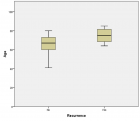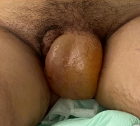Abstract
Research Article
Fecal storage condition induces variations of microbial composition and differential interpretation of metagenomic analysis
Hansoo Park*, Gihyeon Kim†, Kyoung Wan Yoon†, Changho Park†, Kyu Hyuck Kang, Sujeong Kim, Youngmin Yoon, Sang Eun Lee and Yeongmin Kim
Published: 17 March, 2021 | Volume 5 - Issue 1 | Pages: 006-012
Advances in metagenomics have facilitated population studies of associations between microbial compositions and host properties, but strategies to minimize biases in these population analyses are needed. However, the effects of storage conditions, including freezing and preservation buffer, on microbial populations in fecal samples have not been studied sufficiently. In this study, we investigated metagenomic differences between fecal samples stored in different conditions. We collected 46 fecal samples from patients with lung cancer. DNA quality and microbial composition within different storage Methods were compared throughout 16S rRNA sequencing and post analysis. DNA quality and sequencing results for two storage conditions (freezing and preservation in buffer) did not differ significantly, whereas microbial information was better preserved in buffer than by freezing. In a metagenomic analysis, we observed that the microbial compositional distance was small within the same storage condition. Taxonomic annotation revealed that many microbes differed in abundance between frozen and buffer-preserved feces. In particular, the abundances of Firmicutes and Bacteroidetes varied depending on storage conditions. Microbes belonging to these phyla differed, resulting in biases in population metagenomic analysis. We suggest that a unified storage Methods is requisite for accurate population metagenomic studies.
Read Full Article HTML DOI: 10.29328/journal.abse.1001011 Cite this Article Read Full Article PDF
Keywords:
Fecal storage; Metagenomic analysis; Variation; Microbial composition; Population studies
References
- Sekirov I, Russell SL, Antunes LCM, Finlay BB. Gut microbiota in health and disease. Physiol Rev. 2010; 90: 859-904. PubMed: https://pubmed.ncbi.nlm.nih.gov/20664075/
- Oulas A, Pavloudi C, Polymenakou P, Pavlopoulos GA, Papanikolaou N, et al. Metagenomics: Tools and insights for analyzing next-generation sequencing data derived from biodiversity studies. Bioinform Biol Insights. 2015; 9: 75-88. PubMed: https://pubmed.ncbi.nlm.nih.gov/25983555/
- Falony G, Joossens M, Vieira-Silva S, Wang J, Darzi Y, et al. Population-level analysis of gut microbiome variation. Science. 2016; 352; 560-564. PubMed: https://pubmed.ncbi.nlm.nih.gov/27126039/
- He Y, Wu W, Zheng HM, Li P, McDonald D, et al. Regional variation limits applications of healthy gut microbiome reference ranges and disease models. Nat Med. 2018; 24: 1532-1535. PubMed: https://pubmed.ncbi.nlm.nih.gov/30150716/
- Ong IM, Gonzalez JG, McIlwain SJ, Sawin EA, Schoen AJ, et al. Gut microbiome populations are associated with structure-specific changes in white matter architecture. Transl Psychiatry. 2018; 8: 6. PubMed: https://pubmed.ncbi.nlm.nih.gov/29317592/
- Choo JM, Leong LE, Rogers GB. Sample storage conditions significantly influence faecal microbiome profiles. Sci Rep. 2015; 5: 16350.
- Costea PI, Zeller G, Sunagawa S, Pelletier E, Alberti A, et al. Towards standards for human fecal sample processing in metagenomic studies. Nat Biotechnol. 2017; 35: 1069-1076. PubMed: https://pubmed.ncbi.nlm.nih.gov/28967887/
- Gerasimidis K, Bertz M, Quince C, Brunner K, Bruce A, et al. The effect of dna extraction methodology on gut microbiota research applications. BMC Res Notes. 2016; 9: 365. PubMed: https://www.ncbi.nlm.nih.gov/pmc/articles/PMC4960752/
- Shaw AG, Sim K, Powell E, Cornwell E, Cramer T, et al. Latitude in sample handling and storage for infant faecal microbiota studies: The elephant in the room? Microbiome. 2016; 4: 40. PubMed: https://pubmed.ncbi.nlm.nih.gov/27473284/
- Thomas V, Clark J, Doré J. Fecal microbiota analysis: An overview of sample collection methods and sequencing strategies. Future Microbiol. 2015; 10: 1485-1504. PubMed: https://pubmed.ncbi.nlm.nih.gov/26347019/
- Clemente JC, Pehrsson EC, Blaser MJ, Sandhu K, Gao Z, et al. The microbiome of uncontacted amerindians. Sci Adv. 2015; 1: e1500183. PubMed: https://pubmed.ncbi.nlm.nih.gov/26229982/
- Cardona S, Eck A, Cassellas M, Gallart M, Alastrue C, et al. Storage conditions of intestinal microbiota matter in metagenomic analysis. BMC Microbiol. 2015; 12: 158. PubMed: https://pubmed.ncbi.nlm.nih.gov/22846661/
- Roesch LF, Casella G, Simell O, Krischer J, Wasserfall CH, et al. Influence of fecal sample storage on bacterial community diversity. Open Microbiol J. 2009; 3, 40-46. PubMed: https://pubmed.ncbi.nlm.nih.gov/19440250/
- Stephan J, Ott MM, Timmis KN, Hampe J, Wenderoth DF, et al. In vitro alterations of intestinal bacterial microbiota in fecal samples during storage. Diagn Microbiol Infect Dis. 2004; 50: 237-245. PubMed: https://pubmed.ncbi.nlm.nih.gov/15582296/
- Gorzelak MA, Gill SK, Tasnim N, Ahmadi-Vand Z, Jay M, et al. Methods for improving human gut microbiome data by reducing variability through sample processing and storage of stool. PLoS One. 2015; 10: e0134802. PubMed: https://pubmed.ncbi.nlm.nih.gov/26252519/
- Voigt AY, Costea PI, Kultima JR, Li SS, Zeller G, et al. Temporal and technical variability of human gut metagenomes. Genome Biol. 2015; 16: 73. PubMed: https://pubmed.ncbi.nlm.nih.gov/25888008/
- Blekhman R, Tang K, Archie EA, Barreiro LB, Johnson ZP, et al. Common methods for fecal sample storage in field studies yield consistent signatures of individual identity in microbiome sequencing data. Sci Rep. 2016; 6: 31519. PubMed: https://pubmed.ncbi.nlm.nih.gov/27528013/
- Bundgaard-Nielsen C, Hagstrom S, Sorensen S. Interpersonal variations in gut microbiota profiles supersedes the effects of differing fecal storage conditions. Sci Rep. 2018; 8: 17367. PubMed: https://pubmed.ncbi.nlm.nih.gov/30478355/
- Davis MP, van Dongen S, Abreu-Goodger C, Bartonicek N, Enright AJ. Kraken: A set of tools for quality control and analysis of high-throughput sequence data. Methods. 2016; 63: 41-49. PubMed: https://pubmed.ncbi.nlm.nih.gov/23816787/
- Martin M. Cutadapt removes adapter sequences from high-throughput sequencing reads. 2011; 17: 3.
- Bolyen E, Rideout JR, Dillon MR, Bokulich NA, Abnet C, et al. Qiime 2: Reproducible, interactive, scalable, and extensible microbiome data science. 2018; 2167-9843.
- Segata N, Izard J, Waldron L, Gevers D, Miropolsky L, et al. Metagenomic biomarker discovery and explanation. Genome Biol. 2011; 12: R60. PubMed: https://pubmed.ncbi.nlm.nih.gov/21702898/
- Team RC. R: A language and environment for statistical computing. 2013.
- Wickham H. Ggplot2: Elegant graphics for data analysis. 2016.
- Bhatt AP, Redinbo MR, Bultman SJ. The role of the microbiome in cancer development and therapy. CA Cancer J Clin. 2017; 67: 326-344. PubMed: https://pubmed.ncbi.nlm.nih.gov/28481406/
- Song W, Anselmo AC, Huang L. Nanotechnology intervention of the microbiome for cancer therapy. Nat Nanotechnol. 2019; 14: 1093-1103. PubMed: https://pubmed.ncbi.nlm.nih.gov/31802032/
- Wang J, Jia H. Metagenome-wide association studies: Fine-mining the microbiome. Nat Rev Microbiol. 2016; 14: 508-522. PubMed: https://pubmed.ncbi.nlm.nih.gov/27396567/
- Zhuang H, Wang Y, Zhang YK, Zhao MF, Liang GD, et al. Dysbiosis of the gut microbiome in lung cancer. Front Cellular Infect Microbiol. 2019; 9: 112. PubMed: https://www.ncbi.nlm.nih.gov/pmc/articles/PMC6489541/
- Cameron SJ, Huws SA, Hegarty MJ, Smith DP, Mur LA. The human salivary microbiome exhibits temporal stability in bacterial diversity. FEMS Microbiol Ecol. 2015; 91: fiv091. PubMed: https://pubmed.ncbi.nlm.nih.gov/26207044/
- Claesson MJ, Cusack S, O'Sullivan O, Greene-Diniz R, de Weerd H, et al. Composition, variability, and temporal stability of the intestinal microbiota of the elderly. Proc Nat Acad Sci. 2011; 108: 4586-4591. PubMed: https://pubmed.ncbi.nlm.nih.gov/20571116/
- Costello EK, Lauber CL, Hamady M, Fierer N, Gordon JI, Knight R. Bacterial community variation in human body habitats across space and time. Science. 2009; 326: 1694-1697. PubMed: https://pubmed.ncbi.nlm.nih.gov/19892944/
- Oh J, Byrd AL, Park M, Kong HH, Segre JA, et al. Temporal stability of the human skin microbiome. Cell. 2016; 165: 854-866. PubMed: https://pubmed.ncbi.nlm.nih.gov/27153496/
- 16s metagenomic sequencing library preparation. Part #15044223 Rev. 2015; 1-28.
- McDonald D, Price MN, Goodrich J, Nawrocki EP, DeSantis TZ, et al. An improved greengenes taxonomy with explicit ranks for ecological and evolutionary analyses of bacteria and archaea. ISME J. 2012; 6: 610-618.
- Callahan BJ, McMurdie PJ, Rosen MJ, Han AW, Johnson AJ, et al. Dada2: High-resolution sample inference from illumina amplicon data. Nat Methods. 2016; 13: 581-583. PubMed: https://pubmed.ncbi.nlm.nih.gov/27214047/
- Hughes R, Alkan Z, Keim NL, Kable ME. Impact of sequence variant detection and bacterial dna extraction methods on the measurement of microbial community composition in human stool. bioRxiv. 2017; 212134.
- Bibi F, Ali Z. Measurement of diversity indices of avian communities at taunsa barrage wildlife sanctuary, pakistan. J Animal Plant Sci. 2013; 23: 469-474.
- Menke S, Gillingham MAF, Wilhelm K, Sommer S. Home-made cost effective preservation buffer is a better alternative to commercial preservation methods for microbiome research. Front Microbiol. 2017; 8: 102. PubMed: https://pubmed.ncbi.nlm.nih.gov/28197142/
- Ellis RJ, Bruce KD, Jenkins C, Stothard JR, Ajarova L, Mugisha L, et al. Comparison of the distal gut microbiota from people and animals in africa. PLoS One. 2013; 8: e54783. PubMed: https://pubmed.ncbi.nlm.nih.gov/23355898/
- Lee JE, Lee S, Sung J, Ko G. Analysis of human and animal fecal microbiota for microbial source tracking. ISME J. 2011; 5: 362-365. PubMed: https://pubmed.ncbi.nlm.nih.gov/20686512/
- Davenport ER, Cusanovich DA, Michelini K, Barreiro LB, Ober C, et al. Genome-wide association studies of the human gut microbiota. PLoS One. 2015; 10: e0140301. PubMed: https://pubmed.ncbi.nlm.nih.gov/26528553/
- David LA, Materna AC, Friedman J, Campos-Baptista MI, Blackburn MC, et al. Host lifestyle affects human microbiota on daily timescales. Genome Biol. 2014; 15: R89. PubMed: https://pubmed.ncbi.nlm.nih.gov/25146375/
- David LA, Maurice CF, Carmody RN, Gootenberg DB, Button JE, et al. Diet rapidly and reproducibly alters the human gut microbiome. Nature. 2014; 505-559. PubMed: https://pubmed.ncbi.nlm.nih.gov/24336217/
- Bahl MI, Bergstrom A, Licht TR. Freezing fecal samples prior to dna extraction affects the firmicutes to bacteroidetes ratio determined by downstream quantitative pcr analysis. FEMS Microbiol Lett. 2012; 329: 193-197. PubMed: https://pubmed.ncbi.nlm.nih.gov/22325006/
- Fouhy F, Deane J, Rea MC, O'Sullivan O, Ross RP, et al. The effects of freezing on faecal microbiota as determined using miseq sequencing and culture-based investigations. PLoS One. 2015; 10: e0119355. PubMed: https://pubmed.ncbi.nlm.nih.gov/25748176/
- Rios-Covian D, Salazar N, Gueimonde M, de los Reyes-Gavilan CG. Shaping the metabolism of intestinal bacteroides population through diet to improve human health. Front Microbiol. 2017; 8. 376. PubMed: https://pubmed.ncbi.nlm.nih.gov/28326076/
- Allen-Vercoe E, Jobin C. Fusobacterium and enterobacteriaceae: Important players for crc? Immunol Lett. 2014; 162: 54-61. PubMed: https://pubmed.ncbi.nlm.nih.gov/24972311/
- Fugmann M, Breier M, Rottenkolber M, Banning F, Ferrari U, et al. The stool microbiota of insulin resistant women with recent gestational diabetes, a high risk group for type 2 diabetes. Sci Rep. 2015; 5: 13212. PubMed: https://pubmed.ncbi.nlm.nih.gov/26279179/
- Wu WK, Chen CC, Panyod S, Chen RA, Wu MS, et al. Optimization of fecal sample processing for microbiome study - the journey from bathroom to bench. J Formos Med Assoc. 2019; 118: 545-555. PubMed: https://pubmed.ncbi.nlm.nih.gov/29490879/
Figures:

Figure 1
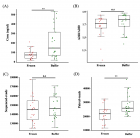
Figure 2
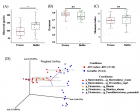
Figure 3
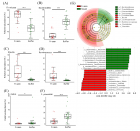
Figure 4

Figure 5
Similar Articles
-
Mesoscopic irreversible thermodynamics of morphological evolution kinetics of helical conformation in bioproteins ‘DNA’ under the isothermal isobaric conditionsTarik Omer Ogurtani*,Ersin Emre Oren. Mesoscopic irreversible thermodynamics of morphological evolution kinetics of helical conformation in bioproteins ‘DNA’ under the isothermal isobaric conditions. . 2020 doi: 10.29328/journal.abse.1001008; 4: 009-019
-
Fecal storage condition induces variations of microbial composition and differential interpretation of metagenomic analysisHansoo Park*,Gihyeon Kim†,Kyoung Wan Yoon†, Changho Park†,Kyu Hyuck Kang,Sujeong Kim,Youngmin Yoon,Sang Eun Lee,Yeongmin Kim. Fecal storage condition induces variations of microbial composition and differential interpretation of metagenomic analysis. . 2021 doi: 10.29328/journal.abse.1001011; 5: 006-012
Recently Viewed
-
Agriculture High-Quality Development and NutritionZhongsheng Guo*. Agriculture High-Quality Development and Nutrition. Arch Food Nutr Sci. 2024: doi: 10.29328/journal.afns.1001060; 8: 038-040
-
A Low-cost High-throughput Targeted Sequencing for the Accurate Detection of Respiratory Tract PathogenChangyan Ju, Chengbosen Zhou, Zhezhi Deng, Jingwei Gao, Weizhao Jiang, Hanbing Zeng, Haiwei Huang, Yongxiang Duan, David X Deng*. A Low-cost High-throughput Targeted Sequencing for the Accurate Detection of Respiratory Tract Pathogen. Int J Clin Virol. 2024: doi: 10.29328/journal.ijcv.1001056; 8: 001-007
-
A Comparative Study of Metoprolol and Amlodipine on Mortality, Disability and Complication in Acute StrokeJayantee Kalita*,Dhiraj Kumar,Nagendra B Gutti,Sandeep K Gupta,Anadi Mishra,Vivek Singh. A Comparative Study of Metoprolol and Amlodipine on Mortality, Disability and Complication in Acute Stroke. J Neurosci Neurol Disord. 2025: doi: 10.29328/journal.jnnd.1001108; 9: 039-045
-
Development of qualitative GC MS method for simultaneous identification of PM-CCM a modified illicit drugs preparation and its modern-day application in drug-facilitated crimesBhagat Singh*,Satish R Nailkar,Chetansen A Bhadkambekar,Suneel Prajapati,Sukhminder Kaur. Development of qualitative GC MS method for simultaneous identification of PM-CCM a modified illicit drugs preparation and its modern-day application in drug-facilitated crimes. J Forensic Sci Res. 2023: doi: 10.29328/journal.jfsr.1001043; 7: 004-010
-
A Gateway to Metal Resistance: Bacterial Response to Heavy Metal Toxicity in the Biological EnvironmentLoai Aljerf*,Nuha AlMasri. A Gateway to Metal Resistance: Bacterial Response to Heavy Metal Toxicity in the Biological Environment. Ann Adv Chem. 2018: doi: 10.29328/journal.aac.1001012; 2: 032-044
Most Viewed
-
Evaluation of Biostimulants Based on Recovered Protein Hydrolysates from Animal By-products as Plant Growth EnhancersH Pérez-Aguilar*, M Lacruz-Asaro, F Arán-Ais. Evaluation of Biostimulants Based on Recovered Protein Hydrolysates from Animal By-products as Plant Growth Enhancers. J Plant Sci Phytopathol. 2023 doi: 10.29328/journal.jpsp.1001104; 7: 042-047
-
Sinonasal Myxoma Extending into the Orbit in a 4-Year Old: A Case PresentationJulian A Purrinos*, Ramzi Younis. Sinonasal Myxoma Extending into the Orbit in a 4-Year Old: A Case Presentation. Arch Case Rep. 2024 doi: 10.29328/journal.acr.1001099; 8: 075-077
-
Feasibility study of magnetic sensing for detecting single-neuron action potentialsDenis Tonini,Kai Wu,Renata Saha,Jian-Ping Wang*. Feasibility study of magnetic sensing for detecting single-neuron action potentials. Ann Biomed Sci Eng. 2022 doi: 10.29328/journal.abse.1001018; 6: 019-029
-
Pediatric Dysgerminoma: Unveiling a Rare Ovarian TumorFaten Limaiem*, Khalil Saffar, Ahmed Halouani. Pediatric Dysgerminoma: Unveiling a Rare Ovarian Tumor. Arch Case Rep. 2024 doi: 10.29328/journal.acr.1001087; 8: 010-013
-
Physical activity can change the physiological and psychological circumstances during COVID-19 pandemic: A narrative reviewKhashayar Maroufi*. Physical activity can change the physiological and psychological circumstances during COVID-19 pandemic: A narrative review. J Sports Med Ther. 2021 doi: 10.29328/journal.jsmt.1001051; 6: 001-007

HSPI: We're glad you're here. Please click "create a new Query" if you are a new visitor to our website and need further information from us.
If you are already a member of our network and need to keep track of any developments regarding a question you have already submitted, click "take me to my Query."








